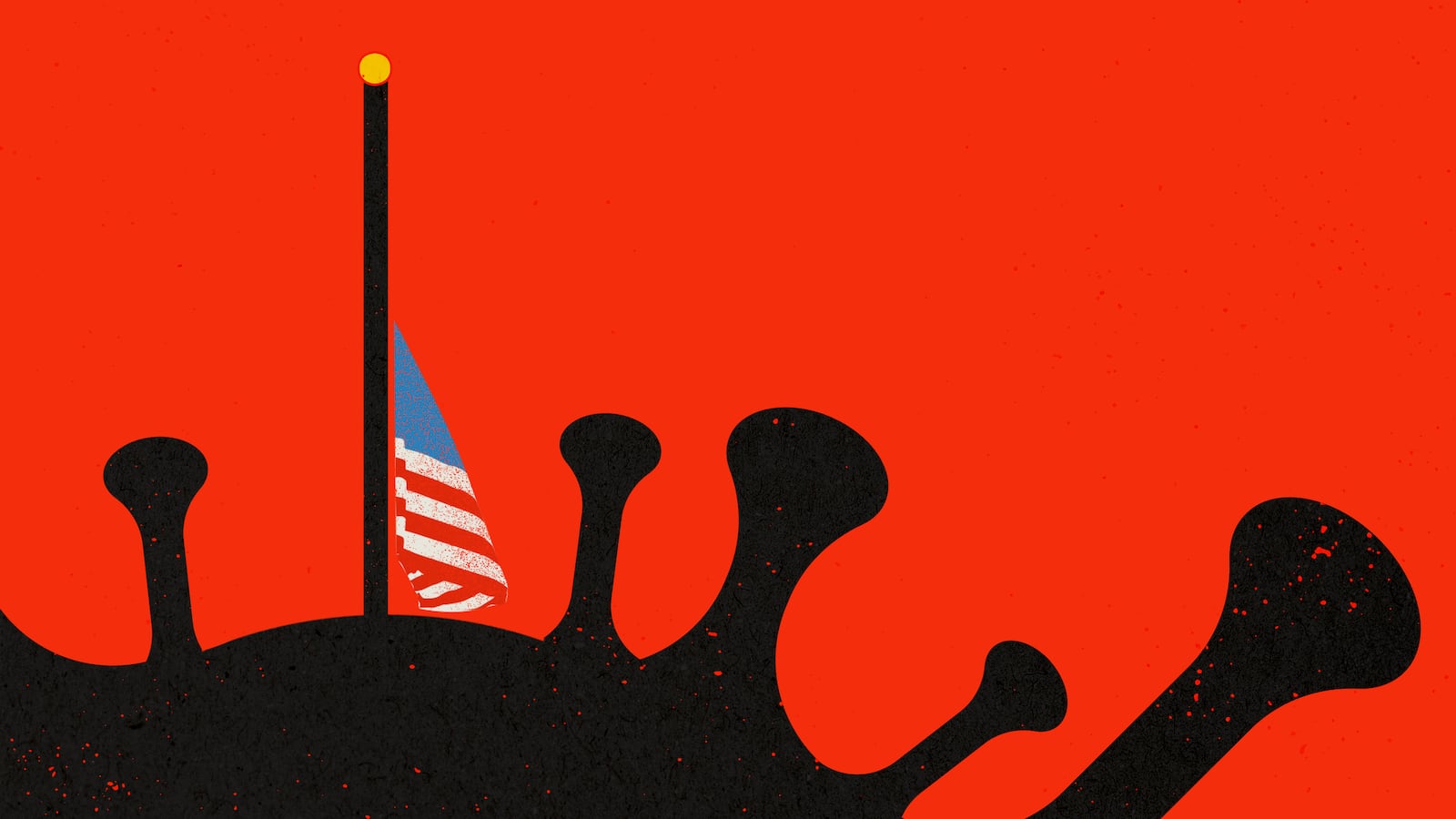Depending on which death tracker you take as gospel, the United States has either already eclipsed or will soon surpass a million lives lost to COVID-19, a figure that is likely a major undercount, and was marked by President Biden on Thursday. Meanwhile, the administration is warning the country could see some 100 million new coronavirus infections this fall and winter.
Vaccines are working and life is veering back toward some semblance of normal. But the death spiral continues, and many Americans insist on burying their heads in the sand.
Shanghai, the world’s largest city, remains in lockdown, a symbol of China’s failed Zero COVID strategy. But in America, we no longer worry about such trivial things. Masks have come off in airports and on planes thanks to a single judge in Florida. Now, helpful articles instruct concerned passengers how to politely ask a seat-mate to mask up, hopefully without producing a violent response. The cruise ships are back sailing, and passengers have fallen ill. The White House Correspondents dinner came back, and surprise, senior officials and correspondents came down with COVID-19.

That the public is desperate for COVID to be “over” is, of course, nothing new. But make no mistake: This pandemic is nowhere close to finished. Numbers are already ticking up nationally—first cases, then hospitalizations, and while death rates have held largely steady, they may soon increase. And in the next weeks and months, a new subvariant may cause a new surge, even as one study of Israeli wastewater surveillance is reportedly predicting a vicious return of the more deadly Delta variant this summer or fall.
Far too many Americans are whistling through a crowded graveyard that our apathy and negligence may soon expand. We expect thousands of new deaths in the coming weeks as we throw away masks, while vaccination and booster rates flounder. And the next wave of caskets may be some of the smallest yet.
The United States ranks near the bottom among our peer nations in our vaccination rate. And our performance on boosters is still worse—a worrying sign amidst variants that are sometimes escaping vaccine protection and with vaccine effectiveness waning.

But as dire as the situation is with adult vaccinations and boosters, it is far worse for childhood vaccinations. Although vaccination for kids aged 5 to 11 became available late last October, barely more than a quarter (29 percent) of them are protected today. Nearly 20 million Americans aged 5 to 11 remain unprotected. More than 13 million kids have been infected, over 8,000 hospitalized, and more than a thousand are dead.
The rampant spread of newer, more transmissible COVID-19 variants makes these kids sitting ducks.
Some vaccine experts are now recommending additional boosters for kids aged 5 to 11. With the Moderna submission and ongoing communication from Pfizer, the push remains furious for the FDA to authorize vaccines for children under 5. We expect the agency to act early next month. But given the extraordinarily low uptake among 5-to-11-year-olds (and low rates among adolescents), we also expect pediatric vaccines to frequently sit on the shelf.
To make matters worse, routine childhood immunizations have fallen during the pandemic years, which now threatens to haunt us with fully preventable outbreaks of measles, mumps, chickenpox, rubella, and whooping cough. And don’t forget the huge backlog in routine medical diagnoses and treatments that have been delayed. Excess death will continue for years as deaths from diabetes, cancer, and heart disease skyrocket.
There are small “winnable” battles here, including, at a minimum, refocusing and reinvigorating pediatric vaccinations against COVID-19, but also against the whole suite of vaccine-preventable childhood illnesses.
Parents may have heard that the newer Omicron variants seem to cause less severe disease with less risk of hospitalization, so they don’t see the urgency of vaccinating their children. Yet, the CDC has confirmed that, at least under the initial Omicron wave, unvaccinated children aged 5 to 11 were twice as likely to be hospitalized with COVID-19, which suggests strongly that pediatric COVID-19 vaccination does protect children from severe disease. It’s worse for children under 5, who are not yet eligible for vaccination; hospitalizations of very young children were five times higher during the initial Omicron surge than in the peak of the Delta variant.

The need to reinvigorate efforts to vaccinate children against COVID-19 is obvious, but the Biden administration doesn’t appear to have a real plan for a national, coordinated campaign. We need to make a compelling case to parents to vaccinate their children. We must also make access far easier and more equitable. Many parents who refuse to get their kids vaccinated are themselves vaccinated. It will take a major push to get parents to act.
We already have community-based vaccine initiatives, such as “Made to Save,” which focuses on minority and hard-to-reach populations. That campaign has done extensive groundwork and team-building to launch community-based pediatric outreach programs, but will reach its planned “sunset” at the end of May.
And the funds for efforts like these are running out quickly. Biden’s COVID relief package has stalled in Congress, threatening testing, vaccination, and treatment programs that are urgently needed. The president said as much when he acknowledged the million-death mark, called for more funding and supplies, and urged renewed vigilance on Thursday. As the nation passes the landmark of 1 million COVID deaths, and with the prospect of new, more dangerous variants, now is not the time to shortchange the COVID response.
At an absolute minimum, Ashish Jha, the energetic new White House COVID-19 coordinator, should launch a nationwide pediatric vaccine strategy. We propose the White House spearhead a “Protect your Child” campaign, including vaccine literacy and outreach in time for the summer holiday (and for those under 5, to get the campaign well underway before their first day of kindergarten in the fall). This could include expanding access to vaccinations in places where parents and kids gather—schools, parks, fairs, churches, and sporting events.

We should also leverage national retail chains, insurers, and employers to support efforts to provide solid facts and leverage real-world testimonials that already exist. Parents also should be provided gift cards, and other financial incentives that have successfully increased vaccine coverage in some communities need to go national.
We must reinforce the age-old social norms around full family vaccine protection—from COVID to flu to shingles. For example, wherever adults get vaccinated or boosted, their provider should ask them about the vaccination status of their children and encourage they get them vaccinated. Personal follow-up nudges will be required.
We must resist taking any victory laps for our efforts to control COVID, particularly among the old and immunocompromised and those with underlying conditions, and especially among the very young. Today, more than six months since children aged 5 to 11 were eligible for COVID vaccines—and a year since 12-to-15-year-olds became eligible—we are failing them badly. We still need strong public-health leadership and motivated community and primary-care provider support at the grassroots level across America.
If we fail to recognize how high the stakes continue to be, we might still go bust.








